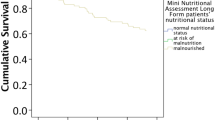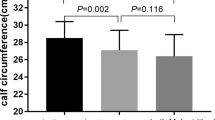Abstract
Background/Objectives
To examine Mini-Nutritional Assessment short form (MNA-SF) and Nutritional Risk Screening 2002 (NRS2002) as prognostic indicators of postoperative complications, length of hospital stay (LOS), readmissions, mobility, living arrangements and mortality after hip fracture.
Subjects/Methods
Population-based prospective data were collected on 265 consecutive hip fracture patients aged 65 and over. Nutritional status according to MNA-SF and NRS2002 was assessed on admission. Outcomes were postoperative complications, LOS, readmissions and mortality 1 and 4 months post fracture and changes in mobility level and living arrangements 4 months post fracture.
Results
At baseline, 18 (7%) patients were malnourished and 108 (41%) at risk of malnutrition according to MNA-SF. According to NRS2002, 11 (4%) patients were at severe risk and 56 (21%) patients at moderate risk of malnutrition. Only MNA-SF predicted mortality, LOS and readmissions. Both instruments proved ineffective in predicting changes in mobility level and living arrangements.
Conclusions
MNA-SF is superior to NRS2002 in predicting short-term hip fracture outcomes.
This is a preview of subscription content, access via your institution
Access options
Subscribe to this journal
Receive 12 print issues and online access
$259.00 per year
only $21.58 per issue
Buy this article
- Purchase on Springer Link
- Instant access to full article PDF
Prices may be subject to local taxes which are calculated during checkout



Similar content being viewed by others
References
Cheng S, Levy A, Lefaivre K, Guy P, Kuramoto L, Sobolev B. Geographic trends in incidence of hip fractures: a comprehensive literature review. Osteoporos Int. 2011;22:2575–86.
Kanis J, Oden A, McCloskey E, Johansson H, Wahl D, Cooper C. A systemic review of hip fracture incidence and probability of fracture worldwide. Osteoporos Int. 2012;23:2239–56.
Stolee P, Poss J, Cook R, Byrne K, Hirdes J. Risk factors for hip fracture in older home care clients. J Gerontol A Biol Sci Med Sci. 2009;64:403–10.
Kaiser M, Bauer J, Rämsch C, Uter W, Guigoz Y, Cederholm T, et al. Frequency of malnutrition in older adults: a multinational perspective using the mini nutritional assessment. J Am Geriatr Soc. 2010;58:1734–8.
Drevet s, Bioteau C, Maziere S, Couturier P, Merloz P, Tonetti J, Gavazzi G. Prevalence of protein-energy malnutrition in hospital patients over 75 years of age admitted for hip fracture. Orthop Trauma Surg Res. 2014;100:669–74.
Correia M, Hegazi R, Higashiguchi T, Michel J, Reddy B, Tappenden K, et al. Evidence-based recommendations for addressing malnutrition in health care: an updated strategy from the feed M.E. Global Study Group. Jamda. 2014;15:544–50.
Nicholson J, Dowrick A, Liew S. Nutritional status and short-term outcome of hip arthroplasty. J Orthop Surg. 2012;20:331–5.
Lim S, Ong K, Chan Y, Loke W, Ferguson M, Daniels L. Malnutrition and its impact on cost of hospitalization, length of stay, readmission and 3-year mortality. Clin Nutr. 2012;31:345–50.
Carpintero P, Caeiro J, Carpintero R, Morales A, Silva S, Mesa M. Complications of hip fractures: a review. World J Orthop. 2014;18:402–11.
Nuotio M, Tuominen P, Luukkaala T. Association of nutritional status as measured by the Mini-Nutritional Assessment Short Form with changes in mobility, institutionalization and death after hip fracture. Eur J Clin Nutr. 2016;70:393–8.
Helminen H, Luukkaala T, Saarnio J, Nuotio M. Comparison of the Mini-Nutritional Assessment short and long form and serum albumin as prognostic indicators of hip fracture outcomes. Injury. 2017;48:903–8.
Kondrup J, Allison S, Elia M, Vellas B, Plauth M. ESPEN Guidelines for Nutrition Screening 2002. Clin Nutr. 2003;22:415–21.
Rasmussen H, Holst M, Kondrup J. Measuring risk in hospitals. Clin Epidemiol. 2010;2:209–16.
van Bokhorst-de van der Schueren M, Guaitoli P, Jansma E, de Vet H. Nutrition screening tools: does one size fit all? A systemic review of screening tools for the hospital setting. Clin Nutr. 2014;33:39–58.
Vellas B, Villars H, Abellan G, Soto M, Rolland Y, Guigoz Y. Overview of the MNA—Its history and challenges. J Nutr Health Aging. 2006;10:456–63.
Rubenstein L, Harker j, Salva A, Guigoz Y, Vellas B. Screening for undernutrition in geriatric practice: developing the short-form mini-nutritional assessment (MNA-SF). J Gerontol a Biol Med Sci. 2001;56:366–72.
Kondrup J, Rasmussen H, Hamberg O, Stanga Z, Ad Hoc ESPEN Working Group. Nutritional risk screening (NRS2002): a new method based on an analysis of controlled clinical trials. Clin Nutr. 2003;22:321–36.
Koren-Hakim T, Weiss A, Hershkovitz A, Otzrateni I, Anbar R, Gross Nevo R, et al. Comparing the adequacy of the MNA-SF, NRS-2002 and MUST nutritional tools in assessing malnutrition in hip fracture operated elderly patients. Clin Nutr. 2016;35:1053–8.
Sankar A, Johnson S, Beattle W, Tait G, Wijeysundera D. Reliability of the American Society of Anesthesiologists physical status scale in clinical practice. Br J Anaesth. 2014;113:424–32.
Suhonen J, Rahkonen T, Juva K, Pitkälä K, Voutilainen P, Erkinjuntti T. The treatment pathway of a memory disorder patient. Duodecim. 2011;127:1107–16.
Zhou J, Wang M, Wang H, Chi Q. Comparison of two nutrition assessment tools in surgical elderly inpatients in Northern China. Nutr J. 2015;14:68.
Holst M, Yifter-Lindgren E, Surowiak M, Nielsen K, Mowe M, Carlsson M, et al. nutritional screening and risk factors in elderly hospitalized patients: association to clinical outcome? Scand J Caring Sci. 2013;27:953–61.
Baek M, Heo Y. Evaluation of the efficacy of nutritional screening tools to predict malnutrition in the elderly at a geriatric care hospital. Nutr Res Pract. 2015;9:637–43.
Bjorgul K, Novicoff W, Saleh K. American Society of Anesthesiologist Physical Status score may be used as a comorbidity index in hip fracture surgery. J Arthoplasty. 2010;25:134–7.
Olofsson B, Stenvall M, Lundström M, Svensson O, Gustafson Y. Malnutrition in hip fracture patients: an intervention study. J Clin Nurs. 2007;16:2027–38.
Bell J, Bauer J, Capra S, Pulle R. Concurrent and predictive evaluation of malnutrition diagnostic measures in hip fracture inpatients: a diagnostic accuracy study. Eur J Clin Nutr. 2014;68:358–62.
Botella-Carretero J, Iglesias B, Balsa J, Arrieta F, Zamarron I, Vazquez C. Perioperative oral nutritional supplements in normally or mildly undernourished geriatric patients submitted to surgery for hip fracture: a randomized clinical trial. Clin Nutr. 2010;29:574–9.
Jie B, Jiang Z, Nolan M, Efron D, Zhu S, Yo K, Kondrup J. Impact of nutritional support on clinical outcome in patients at nutritional risk: a multicenter, prospective cohort study in Baltimore and Beijing teaching hospitals. Nutrition. 2010;26:1088–93.
Cawood A, Elia M, Stratton R. Systemic review and meta-analysis of the effects of high protein oral nutritional supplements. Ageing Res Rev. 2012;11:278–96.
Avenell A, Smith T, Curtain J, Mak J, Myint P. Nutritional supplementation for hip fracture aftercare in older people. Cochrane Database Syst Rev. 2016;30:11:CD001880.
Helminen H, Luukkaala T, Saarnio J, Nuotio M. Changes in nutritional status and associated factors in a geriatric post-hip fracture assessment. Eur Ger Med. 2017;8:134–9.
Jyväkorpi S, Pitkälä K, Puranen T, Björkman M, Kautiainen H, Strandberg T, et al. High proportions of older people with normal nutritional status have poor protein intake and low diet quality. Arch Gerontol Geriatr. 2016;67:40–5.
Acknowledgements
Ms Kaisu Haanpää, RN, is gratefully acknowledged for her expert collection of data and performing the MNAs on patients. This study was financially supported by the State Research Financing of Seinäjoki Central Hospital.
Author information
Authors and Affiliations
Corresponding author
Ethics declarations
Conflict of interest
The authors declare that they have no conflict of interest.
Rights and permissions
About this article
Cite this article
Helminen, H., Luukkaala, T., Saarnio, J. et al. Predictive value of the mini-nutritional assessment short form (MNA-SF) and nutritional risk screening (NRS2002) in hip fracture. Eur J Clin Nutr 73, 112–120 (2019). https://doi.org/10.1038/s41430-018-0267-y
Received:
Revised:
Accepted:
Published:
Issue Date:
DOI: https://doi.org/10.1038/s41430-018-0267-y
This article is cited by
-
Prevalence of undernutrition in surgical patients and the effect on length of hospital stay
Journal of Anesthesia (2022)
-
Preliminary effect and feasibility of physiotherapy with strength training and protein-rich nutritional supplement in combination with anabolic steroids in cross-continuum rehabilitation of patients with hip fracture: protocol for a blinded randomized controlled pilot trial (HIP-SAP1 trial)
Trials (2019)



